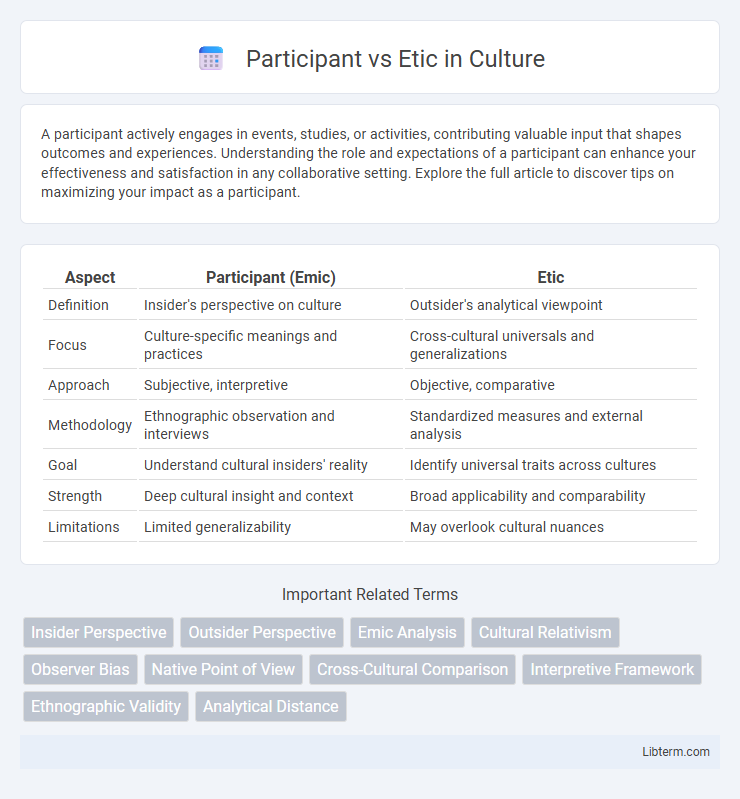A participant actively engages in events, studies, or activities, contributing valuable input that shapes outcomes and experiences. Understanding the role and expectations of a participant can enhance your effectiveness and satisfaction in any collaborative setting. Explore the full article to discover tips on maximizing your impact as a participant.
Table of Comparison
| Aspect | Participant (Emic) | Etic |
|---|---|---|
| Definition | Insider's perspective on culture | Outsider's analytical viewpoint |
| Focus | Culture-specific meanings and practices | Cross-cultural universals and generalizations |
| Approach | Subjective, interpretive | Objective, comparative |
| Methodology | Ethnographic observation and interviews | Standardized measures and external analysis |
| Goal | Understand cultural insiders' reality | Identify universal traits across cultures |
| Strength | Deep cultural insight and context | Broad applicability and comparability |
| Limitations | Limited generalizability | May overlook cultural nuances |
Introduction to Participant and Etic Perspectives
The participant perspective emphasizes understanding experiences and meanings from within the cultural or social group being studied, highlighting insider knowledge and subjective interpretation. The etic perspective involves analyzing cultural phenomena from an outsider's viewpoint, applying universal categories and frameworks to enable cross-cultural comparisons. These approaches are fundamental in anthropology, sociology, and psychology, shaping research design and data interpretation to balance emic insights with etic objectivity.
Defining Participant (Emic) Approach
The Participant (Emic) approach in research emphasizes understanding cultural phenomena from within the social group, capturing insiders' perspectives, beliefs, and experiences. This method prioritizes native categories, meanings, and language to provide an authentic and context-rich interpretation of behaviors and practices. Researchers adopting the Emic approach seek to uncover the subjective reality of participants rather than imposing external frameworks.
Understanding the Etic Perspective
The etic perspective involves analyzing cultures from an outsider's viewpoint, emphasizing objective categories and universal concepts to enable cross-cultural comparison. It contrasts with the participant, or emic, perspective that focuses on an insider's subjective understanding and cultural context. Understanding the etic perspective enhances anthropological research by applying standardized frameworks that identify patterns beyond individual cultural experiences.
Key Differences Between Participant and Etic Views
Participant views emphasize understanding behavior from within a culture by adopting the insider's perspective, highlighting subjective meanings and context-specific interpretations. Etic views approach cultures from an outsider's standpoint, prioritizing objective, comparative analysis using universal categories and standardized criteria. The key difference lies in participant views seeking emic insights through immersion, while etic views aim for cross-cultural generalizations through detachment.
Advantages of the Participant Perspective
The participant perspective offers nuanced insights by capturing the subjective experiences and cultural meanings from within the social group, enriching qualitative research with context-specific understanding. It fosters deeper empathy and rapport between researchers and subjects, which enhances data authenticity and validity. This insider viewpoint facilitates identification of subtle social dynamics that external analyses might overlook, contributing to more comprehensive ethnographic findings.
Strengths of the Etic Approach
The etic approach offers strengths such as providing an outsider's perspective that allows for cross-cultural comparisons and the identification of universal patterns in human behavior. It facilitates the development of standardized methodologies and theories that are generalizable across different cultures. This approach minimizes cultural bias by applying consistent criteria, making it valuable for comparative research and hypothesis testing.
Challenges in Balancing Participant and Etic Methods
Balancing participant and etic methods poses challenges in maintaining objectivity while capturing authentic cultural perspectives. Participant methods provide rich, insider views that risk researcher bias, whereas etic approaches ensure analytical distance but may overlook nuanced meanings. Effective research requires integrating these perspectives to enhance validity without sacrificing depth or cultural sensitivity.
Applications in Research Fields
Participant and etic perspectives serve distinct roles in research fields by shaping data interpretation methods. Participant approaches, emphasizing insider views, are pivotal in anthropology and ethnography for cultural immersion and understanding local contexts. Etic approaches, focusing on external analysis, are essential in psychology and sociology for comparative studies and establishing universal patterns across cultures.
Ethical Considerations
Participant perspectives emphasize the importance of respecting individuals' lived experiences and informed consent in research, ensuring their cultural context and meanings are accurately represented. Etic approaches require researchers to maintain objectivity and avoid imposing their own biases, often necessitating strict adherence to ethical guidelines that protect participant anonymity and confidentiality. Both perspectives demand rigorous ethical standards to balance insider insight with external analysis while safeguarding participant rights.
Choosing the Right Perspective for Your Study
Choosing between participant and etic perspectives depends on your research goals and context; participant (emic) viewpoints prioritize insider experiences and cultural meanings, enhancing depth and authenticity in qualitative studies. Etic perspectives offer outsider analysis, fostering objectivity and comparability by applying universal frameworks across cultures. Balancing these approaches can optimize data relevance and analytical rigor, ensuring your study effectively captures both subjective insights and broader patterns.
Participant Infographic

 libterm.com
libterm.com